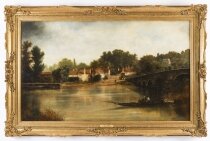A large Spanish oil on canvas of Our Lady of The Rosary after Bartolomé Esteban Murillo, early 19th century in date.
It features the Virgin Mary holding baby Jesus in her arms, she is dressed in a flowing traditional costume set against the background of an ancient building.
This superbly accomplished painting is executed in the style of Murillo's later works where he continued to evolve to the very end. In the last decade of his life, Murillo took Rubens's lesson even closer to heart, during this period his brushwork became looser and more visible than ever before, sometimes even to the point that the canvases appear unfinished.
Murillo also reduced his palette to the more sober hues of mauve, grey, brown, and carmine, making his late style more refined than in any previous period.
His style of painting the street children of his native Seville was unprecedented. He employed great naturalism, employing a sombre palette and strong chiaroscuro, contrasting lights and darks, and very little background detail. They are caught, like a photographic snapshot, playing or eating, but are very rarely aware of an onlooker.
This magnificent painting is housed in a striking gilded frame decorated with acanthus leaves.
It is beautifully executed and as such would make a lovely addition to your collection.
Condition:
In really excellent condition the painting and frame having been beautifully cleaned, please see photos for confirmation.
Dimensions in cm:
Height 175 cm x Width 125 cm x Depth 6.5 cm
Dimensions in inches:
Height 5 foot, 9 inches x Width 4 feet, 1 inch x Depth 3 inches
Our reference: A3489
Please feel free to email or call us (+44 20 8809 9605) to arrange a viewing in our North London warehouse.
Bartolomé Esteban Murillo
Bartolomé Esteban Murillo, (baptized January 1, 1618, Sevilla, Spain—died April 3, 1682, Sevilla), the most popular Baroque religious painter of 17th-century Spain, noted for his idealized, sometimes precious manner. Among his chief patrons were the religious orders, especially the Franciscans, and the confraternities in Sevilla (Seville) and Andalusia.
Among Murillo’s earliest works is the Virgin of the Rosary (c. 1642). In the vestigial style of his artistically conservative Sevillian master, Juan del Castillo, this early work combines 16th-century Italian Mannerism and Flemish realism. The 11 paintings that originally hung in the small cloister of San Francisco in Sevilla—e.g., the Ecstasy of St. Diego of Alcalá (1646)—are executed in the more contemporary naturalistic style of the Sevillian school, established by Diego Velázquez and continued by Francisco de Zurbarán. That series is characterized by realism and tenebrism (contrasting light and shade) and use of commonplace models, with an emphasis on genre or scenes of everyday life.
In the 1650s a striking transformation of style occurred, usually attributed to a visit to Madrid, where Murillo undoubtedly met Velázquez and studied the works of Titian, Peter Paul Rubens, and Anthony van Dyck in the royal collections. The softly modeled forms, rich colours, and broad brushwork of the 1652 Immaculate Conception reflect direct visual contact with the art of the 16th-century Venetians and the Flemish Baroque painters. The St. Leandro and St. Isidoro (1655) are even further removed from the simple naturalism of his earlier Franciscan saints. These seated figures, more than life size, are in the grand manner of Baroque portraiture, which had become fashionable at the Spanish court.
The Vision of St. Anthony (1656), one of Murillo’s most celebrated pictures, is an early example of his so-called “vaporous” style, which was derived from Venetian painting. In 1660 Murillo was one of the founders and first president of the Academy of Painting in Sevilla. During the two following decades he executed several important commissions, generally representing dramatized genre on a grand scale. From 1678 onward Murillo worked on another series of paintings, for the Hospicio de Venerables Sacerdotes in Sevilla, which included the celebrated Soult Immaculate Conception (1678), which was removed to France by Nicolas-Jean de Dieu Soult during the Napoleonic period.
Although Murillo’s subjects were often religious, he also produced many genre paintings of ordinary contemporary life. He depicted the street children of Seville in Grape and Melon Eaters (c. 1645) and glimpses of the aristocracy from the street in Two Women at a Window (c. 1655/1660). Murillo’s late style is exemplified by his unfinished works for the Capuchin church at Cádiz and The Heavenly and Earthly Trinities (c. 1675–82; popularly called the “Holy Family”). The often mystical significance of his subjects is countered by the idealized reality of his figures based on familiar human archetypes, with natural gestures and tender, devout expressions, creating an effect of intimate rather than exalted religious sentiment.
Murillo had many pupils and innumerable followers. His paintings were copied and imitated throughout Spain and its empire. He was the first Spanish painter to achieve widespread European fame, and until the 19th century he was the only Spanish artist whose works were extensively known outside the Hispanic world.
Dimensions in cm:
Height 175 cm x Width 125 cm x Depth 6.5 cm
Dimensions in inches:
Height 5 foot, 9 inches x Width 4 feet, 1 inch x Depth 3 inches
Shipping:
We ship worldwide and delivery within the London M25 is free of charge.
A shipping cost to all other destinations must be requested prior to purchase.
UK shipping times are typically 3-5 business days.
Buyers are fully responsible for any customs duties or local taxes that may be incurred on items sent outside of the United Kingdom, and we are not responsible for any delays in shipping or in the customs procedures of any jurisdiction, which are completely beyond our control.
To request a shipping quote for the items in your cart, please click HERE.
Delivery and return policy:
We require that someone be home on the agreed delivery day if applicable, otherwise a redelivery fee will apply.
In accordance with Distance Selling Regulations, we offer a 14-day money back guarantee if you are not satisfied with the item.
The item must be returned in its original packaging and condition.
Unless the item is not as described in a material way, the buyer is responsible for return shipping expenses.
Buyers are fully responsible for any customs duties or local taxes that may be incurred on items sent outside of the United Kingdom, and we are not responsible for any delays in shipping or in the customs procedures of any jurisdiction, which are completely beyond our control.
Please be advised that claims for damage with certain carriers can sometimes take several months to resolve, and we would be grateful for your patience and cooperation throughout the process.
Returns will be processed and refunds issued within 2-3 business days of receipt.





















